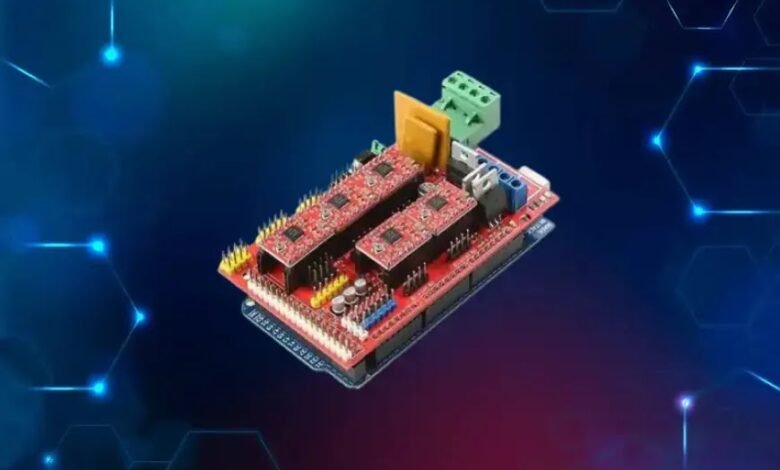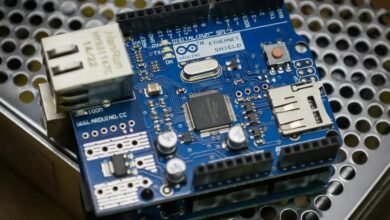RAMPS 1.4: 3D printer control panel

In the dynamic realm of 3D printing, where precision meets creativity, lies a vital component often overshadowed by the grandeur of the printed results: the control panel. Within this control ecosystem, RAMPS 1.4 stands as an unsung hero, silently orchestrating the intricate dance of motors, heaters, and sensors that bring digital designs to tangible fruition.
RAMPS, an acronym for RepRap Arduino Mega Pololu Shield, embodies the convergence of open-source innovation and practical engineering prowess. At its core, RAMPS 1.4 is more than a mere circuit board; it’s a gateway to the realm of possibilities, enabling enthusiasts and professionals alike to harness the full potential of their 3D printers.
In this exploration, we delve into the intricacies of RAMPS 1.4, uncovering its architecture, functionality, and pivotal role in the 3D printing ecosystem. From its humble origins within the RepRap community to its widespread adoption across a myriad of printer models, RAMPS 1.4 has cemented its status as a cornerstone of DIY fabrication.
Join us as we unravel the layers of this unassuming yet indispensable component, shedding light on its inner workings and illuminating the pathways it paves for innovation and experimentation in the ever-evolving landscape of additive manufacturing.
To understand the RAMPS 1.4 motherboard well, and initially, if you are not familiar with Arduino, we invite you to read this related blog post: Arduino: Empowering DIY Projects and Innovation.
What is RAMPS 1.4?
The RepRap Arduino Mega Pololu Shield is a board that acts as an interface between the Arduino Mega – the computer control unit – and the electronic components on a RepRap 3D printer. The computer extracts information from files containing data about the object to be printed and translates it into digital events, such as providing voltage to a specific pin.
Operating and stopping many of these screws to instruct the printer on what to do is required. Unfortunately, the Mega does not have enough power to actually run the printer’s devices.
This is where RAMPS 1.4 comes in. It organizes and amplifies the information coming from the Mega so that it is properly directed to the correct channels.
For example, if the carriage needs to move one step to the left, it directs signals from the Mega to the X-axis stepper motor through the appropriate screws and wires.
It emerged from years of development by the RepRap project. It fulfilled the need for a single control board using Arduino Mega and Pololu drivers to manage all the functions of a 3D printer.
In the spirit of RepRap, it was originally designed to enable home production. It quickly became overly complex, and the design shifted towards commercial boards.
Its basic board design began with version 1.7 and continued (at least) to 1.4 (with holes or surface-mounted components). This board has been widely copied and can be obtained and assembled for less than $10 from Asian manufacturing companies.
RAMPS 1.4 Connectors
It comes with all the necessary components to operate most 3D printers:
- Sockets for 5 stepper driver modules: Stepper drivers are common Pololu drivers available from many sources. Because they are modular components, if one stops working, it can easily be replaced by simply pulling it out and replacing it with a new driver. Three of the stepper drivers are assigned for the X, Y, and Z axes of the printer, while two are assigned for extruders. The Z-axis connector allows for two stepper motors to be driven synchronously. Each stepper motor can be configured to move its motor in steps of 1, 1/2, 1/4, 1/8, or 1/16 per pulse.
- Terminals for 3 heaters: Operated by MOSFETs, they control the amount of power supplied to the device (and thus the amount of heat generated). Typically, one driver will supply the hot-end heater, another will provide the bed heater, and the third will control the fan, which cools the plastic as it is extruded. The fan driver can also be used as a second hot-end driver for dual-extrusion systems.
- Sockets for 3 thermistors: Thermistors measure the temperature of the devices connected to the heaters. The computer control unit can use this information to monitor and control device temperatures.
- Sockets for 6 endstop points: The RAMPS 1.4 board provides sufficient control over endstops to allow the 3D printer to detect motion at the ends of the X, Y, and Z axes (left-right, front-back, top-bottom) to limit the range within which the stepper motor can move printer parts along any axis. Endstops can be mechanical or optical.
- SD card option: Allows you to attach an SD card reader so you can directly read printable files from an SD card instead of connecting to a computer.
- Display connectors: The 10-pin ribbon connector allows for the addition of a display unit.
- Power supply terminals: Includes screw terminals for two 12-volt supplies, one for the bed heater and the other for everything else. Power inputs are merged to prevent damage.
- Lots of other additional features: Provides five extra sockets for unused screws on the Arduino Mega. This allows for additional fans, LED lights, duplicators, and a wide range of peripherals to add extra capacity.
Benefits of RAMPS 1.4
It comes with a number of advantages:
- Accessibility and reliability: The board is cheap and readily available. Recent warnings have been posted on the RepRap website about some very cheap boards that place power and ground traces near each other. However, this is not part of its default design, so boards purchased from reputable suppliers should not face this issue.
- Adaptability: The board is available in assembled board, kit, bare board, and file formats to send to PCB manufacturers. The board layout is widely available.
- Standardized: Pololu stepper driver modules fit into the sockets so they can be easily replaced.
- Open: The design is open source.
- Integrated: The Arduino Mega runs the Marlin firmware, which is highly sophisticated middleware that is easily modifiable and continually evolving, allowing it to operate almost any type of 3D printer.
Note
The RAMPS 1.4 board is constantly evolving. The 1.5 version changed the MOSFET transistor configuration and switches. (Unfortunately, it’s also not open source, violating the original hardware license.)
Version 1.6 added screw terminals, improved cooling of the MOSFET motor transistors, and moved around some components. These are improvements but not functional changes. There is also a version of it that allows it to connect to the Arduino Due, which is 3.3-V.
In conclusion
RAMPS 1.4 stands as a cornerstone in the world of open-source 3D printing. Its versatility, affordability, and widespread adoption have made it a favorite among hobbyists, educators, and professionals alike. As we’ve explored throughout this article, RAMPS 1.4 offers a robust platform for controlling 3D printers, with its compatibility with Arduino boards, expandability through additional stepper drivers, and support for a wide range of firmware options. Its open design encourages innovation and customization, allowing users to tailor their 3D printing experience to their specific needs.
However, it’s important to acknowledge that RAMPS 1.4 is not without its limitations. Issues such as overheating, wiring complexity, and potential compatibility issues with certain components can arise, particularly as users push the boundaries of their printers with higher speeds and resolutions. Additionally, as technology continues to evolve, newer and more advanced controller boards may offer features and performance improvements that surpass those of RAMPS 1.4.
Nevertheless, for many enthusiasts and professionals, RAMPS 1.4 remains a reliable and cost-effective solution for driving their 3D printers. Its open nature fosters a vibrant community of developers and contributors, continually pushing the boundaries of what is possible in the world of 3D printing. As such, while RAMPS 1.4 may have its shortcomings, its impact on the accessibility and democratization of 3D printing cannot be overstated, and its legacy will undoubtedly endure for years to come.





